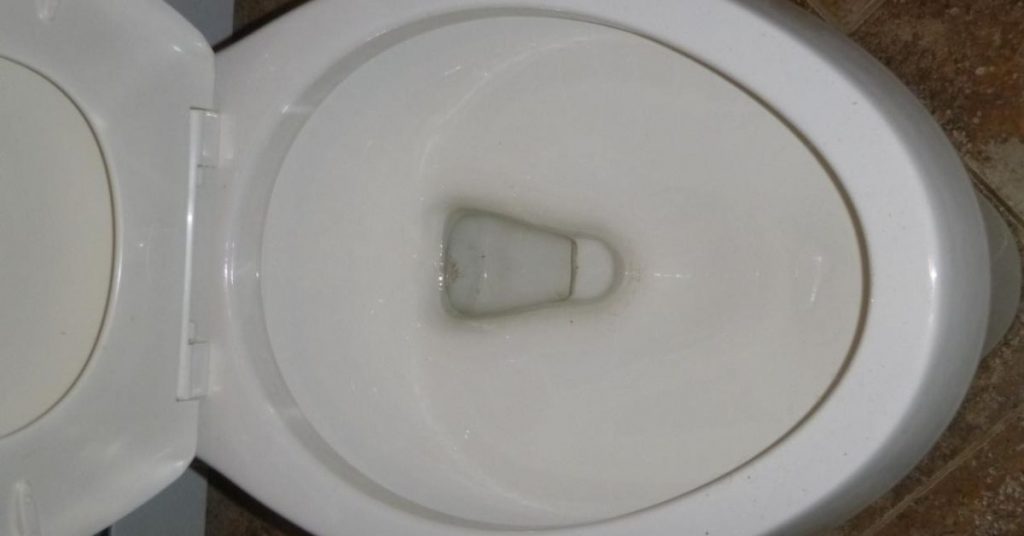
If your toilet won’t flush but instead water rises in the bowl then drains out slowly, you have a clogged toilet (usually a partially clogged toilet) or plumbing vent. To fix the problem, use a plunger or toilet auger to unclog the toilet or climb to the roof of the house and unblock the plumbing vent.
Here is a brief summary of this post:
Causes
- Clogged Drain Line: A blockage in the toilet’s drain line or in the plumbing system downstream can prevent water and waste from flowing away.
- Partial Blockage: Sometimes, there may be a partial blockage in the toilet’s trap or the drainpipe, allowing water to slowly pass through but not enough for a proper flush.
- Improper Venting: Poor venting in your plumbing system can create airlock issues, disrupting the water flow and causing the toilet to malfunction.
- Faulty Flapper: A worn-out or improperly seated flapper in the toilet tank can result in inadequate water release for a flush.
Solutions
- Check for Clogs:
- Use a toilet plunger to attempt to clear a potential clog. Place the plunger over the drain opening, ensuring a good seal, and push down firmly, then pull up quickly. Repeat as needed.
- If the plunger doesn’t work, consider using a toilet auger or snake to reach and remove any deeper clogs.
- Inspect the Tank:
- Lift the toilet tank lid and check the flapper. Ensure it’s not damaged, misaligned, or worn out. Replace it if necessary.
- Venting Issues:
- If you suspect poor venting in your plumbing system, it’s best to consult a professional plumber. Venting problems are complex and may require expert assessment and repairs.
- Use a Bucket: In a pinch, you can manually flush the toilet using a bucket of water. Pour a bucket of water into the bowl in one swift motion to create enough force for a flush.
- Prevent Future Issues:
- To prevent clogs and drainage problems, avoid flushing non-flushable items like paper towels, wipes, or feminine hygiene products.
- Schedule regular plumbing maintenance to keep your drainage system in good condition.
- Professional Help:
- If you’ve tried these steps and the problem persists, or if you suspect a deeper issue with your plumbing, it’s advisable to contact a professional plumber to diagnose and resolve the problem.
Toilet Tank
Toilet tanks are associated with weak flushing toilets. Usually, the water level inside the tank is usually low; meaning the siphon inside the bowl is weak as well during flushing.
In this case, the toilet tank is not the problem since enough water is being delivered to the bowl.
Toilet Trap
A toilet trap, also known as a P-trap is the n-shaped bend on the toilet where it is connected to the drainpipe. If you look at it carefully, you will notice that it goes up then down, where the up leg is shorter than the down leg.
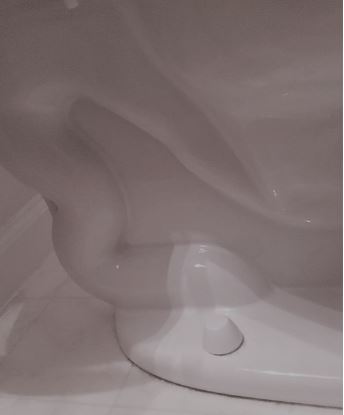
During flushing, water rises up in the first leg of the trap and when it completely fills it the second leg starts to siphon it down to the drainpipe. This is how flushing happens. Just like how you would siphon water or fuel from a container using a hose.
Apart from creating the siphon effect, the toilet trap has 2 other functions:
- It holds a little amount of water at all times. This water acts as a barrier, preventing sewer gases from coming up through the toilet.
- It prevents clogging of the drainpipe. Think about all the times you have dropped items inside the bowl and just lifted them up. Without the P-trap all those items would end up clogging the toilet drain.
The shape of the P-trap is therefore very important but it also presents some problems. Tissue paper and other items you flush have to go up and down inside the P-trap.
If something that is not supposed to be flushed ends up being flushed, it will be trapped inside the P-trap. And that will create a clog.
Whenever you have a clogged toilet, most of the time the clog is usually inside the P-trap. If a toilet won’t flush but water rises in the bowl then drains out slowly, you have a partial clog.
In that case, you will notice that the toilet will drain water but waste and toilet paper will most likely be left behind.
Toilet Drainpipe
It is important to understand how your house plumbing looks like. Each fixture in your house (toilets, sinks, tub, shower and washing machine) has a separate drainpipe. All these drainpipes are all connected to the main drain stack, which is a vertical 4-inch pipe that is connected to the sewer line which drains to the public sewer system or septic tank.
If the main house drainpipe is clogged, you will notice that all of your fixtures will be affected. For instance, you may see waste backing up from the shower drain after flushing the toilet, running washing machine or draining a sink.
If the problem is only affecting the toilet, the clog will be in the toilet drainpipe. Just like with the toilet trap, this could be a partial or solid clog.
Plumbing Vent
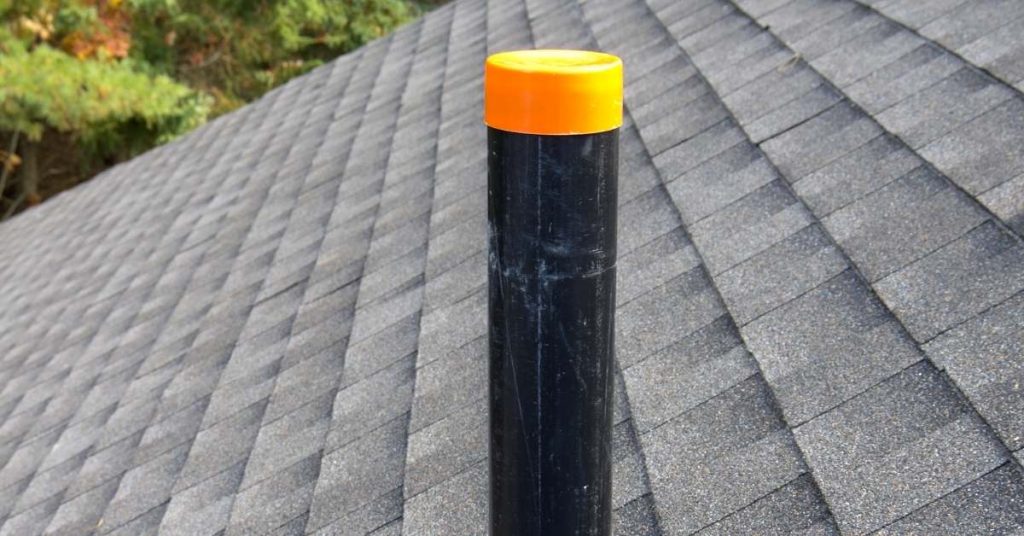
A plumbing vent is the vertical pipe which runs through the roof of the house. It is connected to the main house drain stack. A vent stack has 2 main functions:
- It removes sewer gases from the drainage system, preventing them from coming up through the drains.
- It introduces air into the system. By introducing air into the draining system, your fixtures are able to drain faster and the toilets to flush strongly.
When a plumbing vent is clogged, you will definitely experience a sewer gas smell in your house and your fixtures will be draining slowly. Since the vent serves all the fixtures, the problem will not be isolated to the toilet alone.
If your toilet won’t flush but water rises in the bowl, sinks and tub/showers are draining slowly and there is a sewage smell in the bathroom, you very well have a clogged plumbing vent.
How to Fix a Toilet that Won’t Flush But Water Rises
To fix a toilet that won’t flush but water rises, you have to try and understand the source of the problem as I have above. That way you will know what course of action to take.
The following are the 4 ways to fix a toilet that won’t flush and water rises:
1. Unclog the Plumbing Vent
If after analyzing the problem you have found out that the problem is affecting other drains as well, you need to check and unclog the plumbing vent.
Here is how to unclog a plumbing vent:
- Climb to the roof of the house armed with a garden house.
- If there is a cap at the top of the vent stack, remove it.
- Check if there is trash at the top of the vent that you can easily remove with your hand.
- Stick the garden hose inside the vent and try to dislodge any clog that you may feel.
- Have someone on the ground turn on water to the garden hose. The weight of the water could just be enough to wash down the clog.
- If the clog won’t budge, you will want to upgrade to a better tool. The drain snake (not toilet auger).
- Insert the drain snake inside the vent until your encounter resistance. Start cranking the handle until you go past the restriction.
- Push more cable inside the vent until you are certain that there are no more restrictions.
If a clogged plumbing vent was the source of your problem, you will notice that the toilet will start flushing normally, and that the other fixtures will be draining fast again.
2. Try Plunging
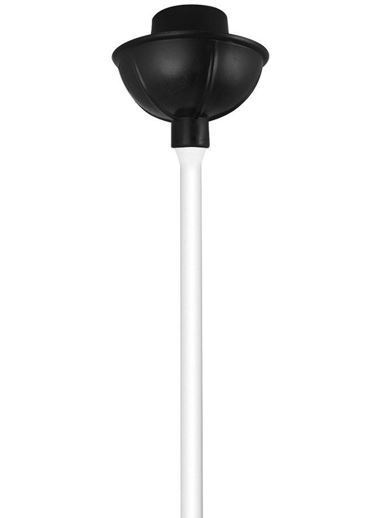
To successful plunge a toilet, you need some water inside the bowl but you don’t want to have a full bowl. The wastewater will splash all over you and the surrounding.
- Start by draining the toilet bowl until it is just about ¼ full.
- Select a good plunger. A good toilet plunger is the bell-shaped one. It seals perfectly around the toilet opening creating maximum pressure and suction.
- Place the plunger on the toilet bowl drain outlet and start plunging gently to get it engaged. Make sure that the cup of the plunger is fully immersed in the water.
- Plunge aggressively for about 3 minutes.
- Lift off the plunger and flush the toilet.
- Check if it is flushing normally again.
- If not plunge it some more.
A toilet plunger will unclog a toilet in most cases but some clogs will need a more powerful tool. A toilet auger is a powerful tool.
3. Snake the Toilet
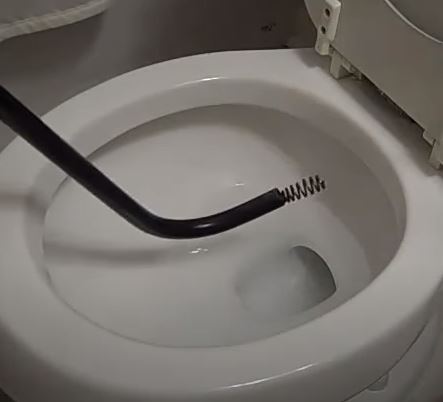
A toilet auger, also known as a toilet snake is a tool specifically made to clear toilet clogs. It has a hooked spring-like head, a flexible cable and a cranking handle.
Toilet augers are usually 4 or 6 feet in length and are a little hard to use compared to toilet plungers. If you are not careful, you can end up badly scratching your toilet bowl’s finish or even damaging your plumbing.
To prevent leaving ugly marks on your toilet bowl, toilet augers have a bowl guard that helps you insert and retrieve the head from the drain without it coming into contact with the inside of the bowl.
A toilet auger will either hook and pull out the clog (like toys and combs) or shred them into smaller pieces which can easily flow down the drainpipe.
Here is how to snake a toilet using a toilet auger:
- Pull back the cable so that the auger head is positioned at the bowl guard.
- Carefully place the auger head and bowl guard at the bowl drain outlet.
- Start pushing the cable down the trap and drainpipe.
- Push the cable until your encounter resistance.
- Strat cranking the handle clockwise slowly. The cable should turn but not twist. If it starts to twist reverse the direction of cranking the handle and start over again until you move past the restriction.
- Slowly pull out the cable.
- Again, place the bowl guard at the bowl drain outlet to help retrieve the auger head without it touching the inside of the bowl and scratching it.
You will either pull out the toilet clog or cut it into smaller pieces. Flush the toilet and check if it is flushing as it should.
4. Remove the toilet
What should you do if a toilet won’t unclog? I believe uninstalling the toilet and removing the clog from the trap or snaking the drainpipe directly is the best solution.
Removing a toilet sounds like a lot of work but it is not. With the toilet out, you will be able to pull out the clog if it is in the toilet trap and if it is in the drainpipe (usually 3 or 4-inch) snaking will be so easy and with a very high success rate.
Just know that if you remove the toilet, you will need to replace the toilet wax ring. A toilet wax ring is however cheap and easy to install.
- Turn off water to the toilet. The shut off valve is on the wall behind the toilet.
- Drain the toilet tank. Lift off the tank lid and place it away in a safe place.
- Scoop water out of the toilet tank until it is completely dry.
- Drain the toilet bowl. Wear rubber gloves and soak up the water remaining at the bottom of the toilet bowl.
- Disconnect the water supply hose. This is the hose connected to the tank. Place a small container underneath it to collect the water still trapped inside.
- Remove the toilet bolts. Toilet bolts are connected on the floor using 2 bolts, one on each side. If the bolts are covered with caps, pry them off with a flathead screwdriver.
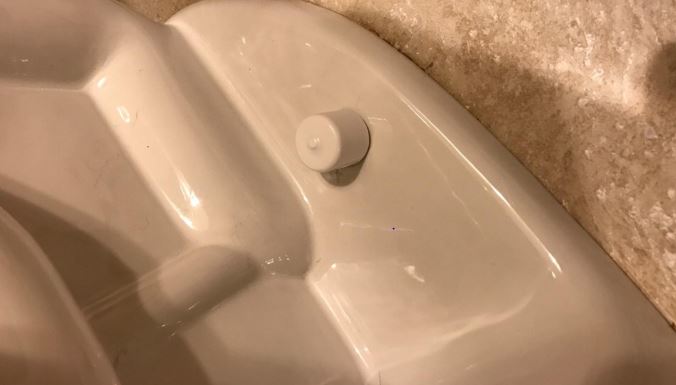
- Loosen the bolt nuts using a wrench or cut them off with a hacksaw blade if they are too corroded.
- Grab the toilet and rock it about to break the wax ring seal.
- Lift off the toilet and slowly lay it on its side. You will need an extra pair of hands for this.
- Scrape off old wax using a putty knife.
- From the bottom of the bottom of the toilet bowl, check if you can see a clog inside the trap. Pull it with your hand.
- If the trap has no clog, snake the toilet drainpipe and remove the clog.
- To install the toilet, start by nicely placing the new wax ring on top of the closet flange.
- Lift off the toilet and lower it slowly. Have your helper align the toilet bolts with the holes on the toilet bowl.
- Place the toilet down slowly and push it down to engage the wax ring. Do no rock it.
- Push in a washer and nut on both bolts and tighten them alternatingly to keep the toilet level.
- Connect the water back and let the tank fill. Flush it a few times to confirm that it is indeed flushing as well as it should.
- Place the tank lid back.
And basically that is how to fix a toilet that won’t flush but water rises. I hope this guide helpful.





